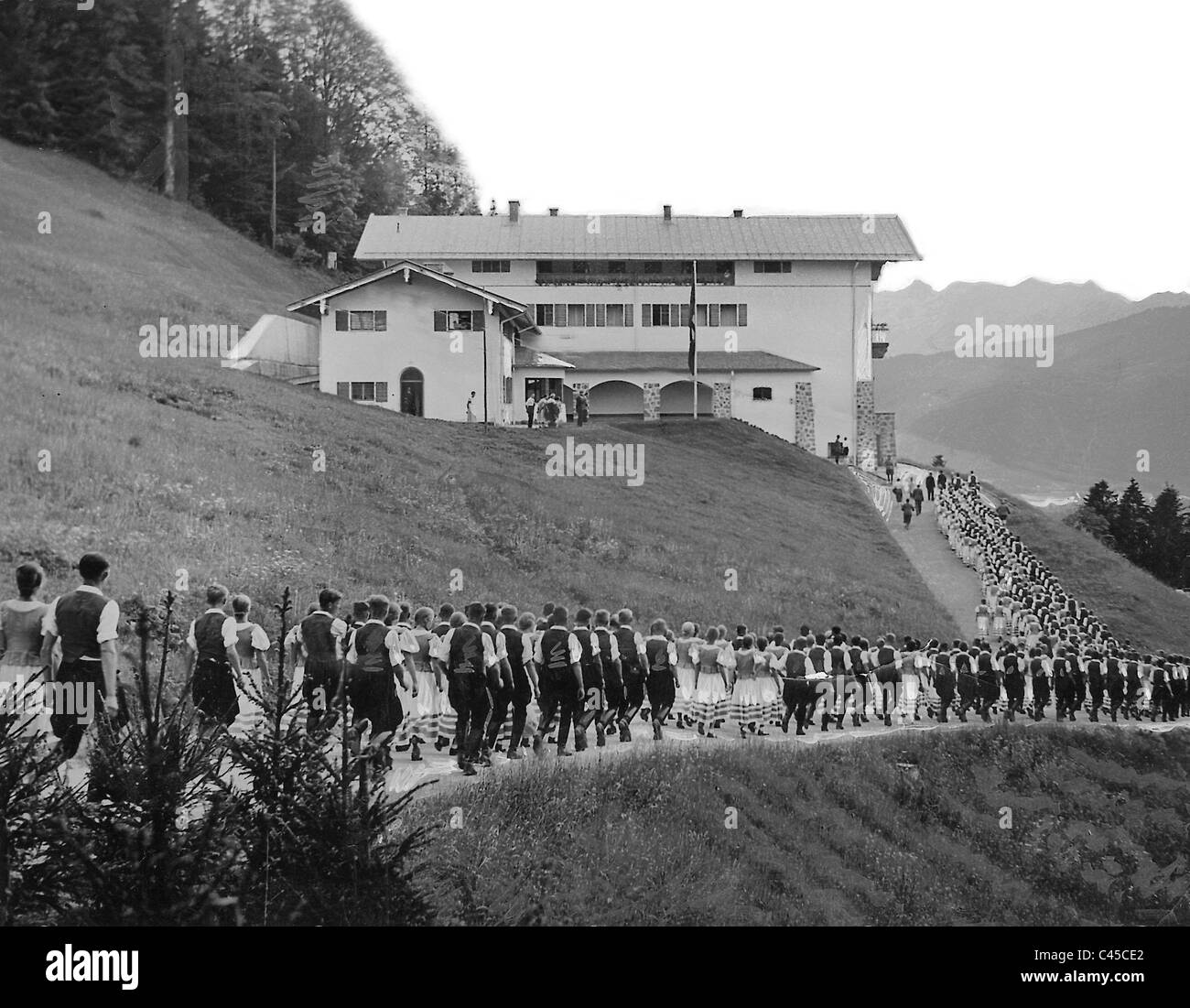The Berghof, Hitler’s once-grand mountain retreat, evokes a potent mix of fascination and unease. Its story, from a modest chalet to a sprawling Nazi headquarters, is deeply intertwined with the rise and fall of the Third Reich. This article explores the Berghof’s history, its dramatic destruction, and its legacy as a site of remembrance and reflection on one of history’s darkest chapters. We will delve into its location, transformation, and the ethical considerations surrounding its modern-day significance as a destination for dark tourism.
The Berghof’s Transformation: A Mountaintop Symbol of Power
Initially a modest home known as “Haus Wachenfeld,” built between 1916 and 1917, the Berghof’s history began long before its association with Hitler. Hitler’s early visits to the nearby Platterhof guesthouse likely solidified the Obersalzberg area in his mind as a location of future importance. He purchased Haus Wachenfeld in 1926, initiating its dramatic transformation into something far grander and more sinister.
From Chalet to Complex: A Reflection of Nazi Ascendancy
Over the ensuing years, the Berghof’s expansion mirrored the Nazi party’s rise to power. It evolved from a small chalet into a sprawling complex, serving as Hitler’s personal sanctuary and a crucial venue for political decision-making. While the Wolfsschanze functioned as his military headquarters, the Berghof represented his personal refuge, a testament to his authority. This idyllic setting, however, belied the horrific events that transpired within its walls. Its frequent use by top Nazi officials further cemented its place in history.
Destruction and Aftermath: A Landscape Scarred by History
The Berghof’s fate changed dramatically on April 25, 1945. Allied bombers, notably elements of No. 617 Squadron RAF (“Dambusters”), launched a devastating attack. Subsequently, the remaining structure was demolished, leaving behind a scarred landscape. While the physical Berghof is gone, its legacy endures—a stark reminder of the regime’s downfall and the catastrophic consequences of its actions. It stands as a critical site for understanding the complexities of Nazi Germany.
Obersalzberg Today: Remembrance and Responsible Tourism
What remains of the Berghof today? Primarily, memories. The original buildings are largely gone, replaced by a grassy field. The nearby Kehlsteinhaus (Eagle’s Nest) serves as a chilling counterpoint, a symbol of both Nazi ambition and the enduring beauty of the Bavarian Alps. Obersalzberg’s current focus is on historical study and responsible tourism, emphasizing respectful remembrance over sensationalism. Memorial efforts aim to educate visitors about the site’s complex history, focusing on learning from the past rather than glorifying it.
Different Perspectives on the Berghof: Beyond Hitler
A complete understanding of the Berghof requires multiple perspectives. This includes comparing its role to other Führer headquarters, such as the Wolfsschanze; exploring the accounts of local people who witnessed the Obersalzberg’s transformation; and analyzing its architecture for insights into Nazi ideology. Furthermore, considering the environmental impact of the Berghof’s construction and subsequent restoration efforts provides a crucial, often-overlooked dimension to its story. These diverse perspectives enrich the narrative and allow for a more nuanced understanding beyond its association with Hitler.
Ethical Tourism and the Berghof’s Legacy: A Sensitive Approach
Visiting the Berghof necessitates careful consideration. How can tourism ensure respect for the site’s significance and the suffering of those who endured that dark period? A responsible approach prioritizes quiet reflection over exploitative sensationalism. It’s about learning, remembering, and reaffirming our commitment to preventing such atrocities from ever happening again. Some experts believe that ongoing research may shed further light on the historical context of the region. Debate continues regarding the most effective methods for balancing memorialization with environmental preservation. Our current understanding, particularly concerning the site’s impact on local communities, might evolve as research progresses.
Can You Still Visit the Berghof? Exploring the Obersalzberg
The Berghof, as a structure, is gone; completely leveled. However, the Obersalzberg area, where it once stood, remains accessible. Visitors encounter not a grand mansion but the remnants of a once-imposing complex, a historical scar on the landscape. This absence itself is a powerful testament to that era.
Exploring the Obersalzberg: More Than Just Ruins
Today, Obersalzberg presents a stark contrast of stunning natural beauty and somber historical significance. The site where the Berghof stood can be visited as part of a broader historical tour. Guided tours provide crucial context and depth, often encompassing other sites like the Eagle’s Nest. The combination of breathtaking scenery and the grim reality of the past creates a truly unforgettable, and emotionally impactful, experience.
The Importance of Responsible Tourism on the Obersalzberg
Visiting demands respectful contemplation. It’s crucial to remember the horrors perpetrated by the Nazi regime; this isn’t casual sightseeing. It’s an opportunity for reflection and learning—a chance to confront the past and understand its enduring implications. Many visitors are deeply moved, grappling with the weight of history. By approaching the site with sensitivity, visitors can gain a deeper understanding of the Berghof and the Obersalzberg’s larger historical context.
Where is Hitler’s Eagle’s Nest Located?
The Eagle’s Nest (Kehlsteinhaus) stands atop Kehlstein mountain, part of the Hoher Göll range near Berchtesgaden, southeastern Germany. Its breathtaking location belies its dark past. Commissioned by Martin Bormann in 1937 and completed in just thirteen months, its construction tragically resulted in the deaths of twelve workers showcasing the Nazi regime’s ruthless efficiency, even at the cost of human life.
The Eagle’s Nest and the Berghof: A Connected History
To fully understand the Eagle’s Nest, one must consider its connection to the Berghof. The Berghof served as Hitler’s principal mountain residence, a sprawling complex located lower down the same mountain. The Eagle’s Nest, therefore, functioned as an extension of that power complex, a luxurious retreat accessible only to a select few.
From Nazi Symbol to Tourist Destination: A Complex Legacy
Today, the Eagle’s Nest attracts numerous visitors each year drawn to its stunning views. Yet, its beauty is inextricably linked to a troubling history, demanding sensitive engagement. Responsible tourism requires acknowledging this painful past and visiting with profound respect for those who suffered under Nazi rule.
Is Hitler’s Berghof Still Standing? The Legacy of Absence
The Berghof’s story blends humble beginnings with infamous notoriety. Originally a modest chalet, its transformation under Hitler’s ownership reflected the Nazi regime’s burgeoning power. But the question remains: can you still see it today? The answer is no. The Berghof was heavily damaged by Allied bombing raids in April 1945. Afterwards, the remaining structures were deliberately demolished to prevent any glorification of the Nazi regime.
The Obersalzberg site, where the Berghof once stood, is now an area of historical reflection and “dark tourism.” It serves as a significant location to confront the past and grapple with the legacy of the Nazi regime and its devastating impact. It is crucial that visitors approach this site with profound respect and remembrance, avoiding any hint of celebratory or insensitive behavior. The absence of the Berghof itself becomes a powerful symbol of the regime’s ultimate downfall and the fragility of power. Ongoing historical debate centers around the significance of preserving or destroying sites linked to such events, highlighting the complexities of memorialization and historical interpretation. Future research may offer evolving perspectives and interpretations on this sensitive topic.
(Remember to insert the internal link “[https://www.lolaapp.com/bermuda-triangle-german-bunker]” naturally within the text at an appropriate point, perhaps within a sentence discussing other lesser-known aspects of WWII or German military history in the region.)
- SYBAU See You Baby Meaning: Gen Z Slang Evolves - July 1, 2025
- Unlock Your Inner Youth: Lifestyle Secrets for a Vibrant Life - July 1, 2025
- Decode SYBAU Meaning: Gen Z Slang Explained - July 1, 2025






